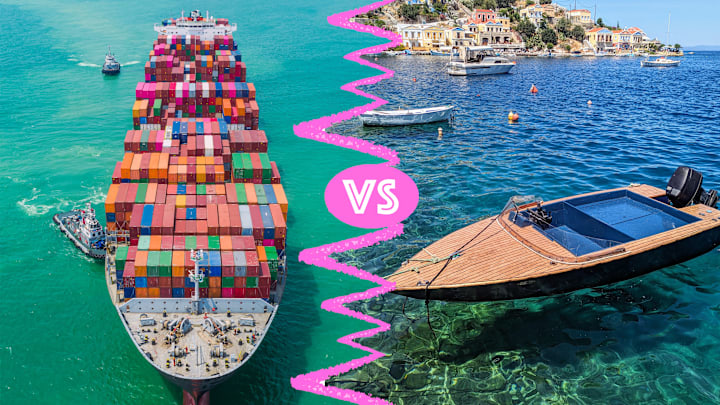In a 2013 case brought by the city of Riviera Beach, Florida, the U.S. Supreme Court, ruled against the defendant, named in the lower court’s proceedings as That Certain Unnamed Gray, Two-Story Vessel Approximately Fifty-Seven Feet in Length [PDF].
At issue was whether the city was right to have seized and destroyed Fane Lozman’s motorless, rudderless floating home under maritime law for unpaid liens, which depended on the definition of the word vessel [PDF]. The court decided Lozman’s “indefinitely moored” home did not meet the legal definition, therefore maritime law did not apply and the city should not have destroyed it. That Certain Unnamed Gray, Two Story Vessel won its case.
According to the U.S. Code, a vessel is any “watercraft or other artificial contrivance used, or capable of being used, as a means of transportation on water,” including ships and boats. Now, it gets complicated.
Are a ship and a boat the same thing?
You will instantly reveal yourself as a landlubber if you refer to a ship as a boat, but, unfortunately, there’s no agreed-upon distinction between the two. Even experienced mariners rely on local custom and usage to differentiate them.
During the Age of Sail, a ship was pretty well defined as a vessel with two or more square rigged masts. As steam power replaced wind and sail, the ships of old became more specifically known as “sailing ships,” and the usage of ship broadened to cover a wider variety of vessels.
One thing that sets a ship apart from a boat is size. According to the U.S. Naval Institute, a boat, generally speaking, is small enough to be carried aboard a larger vessel, a.k.a. a ship. As some sailors say, “You can put a boat on a ship, but you can’t put a ship on a boat.”
This naval convention is a good rule of thumb, but there are a few exceptions among naval and civilian vessels. Some yachts, ferries, tug boats, fishing boats, and police boats can carry small lifeboats or dinghies, but they usually don’t graduate to ship status because of that.
The U.S. Navy seems to want to have it both ways with their submarines. One component of each sub’s official name is USS—that is, United States Ship—but service members usually refer to submarines as boats, regardless of size.
When in doubt, ask the skipper.
Another factor is the vessel’s crew, command, and use. If it has a permanent crew with a commanding officer, it’s usually a ship. If it’s crewed only when actually in use and has no official commanding officer, then you’re probably dealing with a boat. Ships are also usually intended and designed for deep-water use and are able to operate independently for long periods of time. Boats, meanwhile, lack the fuel and cargo capacity for extended, unassisted operation.
Again, there are some exceptions in actual usage. Most commercial fishing vessels, for example, are large and can go out alone on the open ocean for weeks at a time. They’re almost always called boats, though, and rarely fishing ships.
Without any hard and fast rules about boats and ships, we humbly suggest another loose guideline that will ingratiate you to the captain of any sort of vessel: Call it whatever the skipper wants you to call it.
Read More Fascinating Maritime Stories:
A version of this story was published in 2013; it has been updated for 2025.
